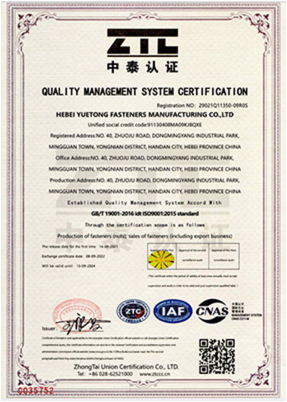Nov . 16, 2024 19:40 Back to list
Understanding the Functions and Applications of Carriage Bolts in Construction
Understanding Carriage Bolts and Their Applications
Carriage bolts, often referred to as coach bolts, are an essential component in the world of construction and engineering. Renowned for their distinctive design, these fasteners are characterized by a rounded head and a square neck that fits into a pre-drilled hole, preventing the bolt from turning during installation. This unique design makes carriage bolts particularly suitable for a variety of applications, ensuring secure and stable assemblies.
The “DIN” in carriage bolt DIN refers to the German Institute for Standardization (Deutsches Institut für Normung), which sets the industry standards for various fasteners, ensuring consistency and reliability. Carriage bolts meeting DIN standards are widely regarded for their quality and durability. When discussing carriage bolts, it's essential to understand their various components, specifications, and uses.
Key Features of Carriage Bolts
1. Design As previously mentioned, the round head and square neck are defining features of carriage bolts. The round head provides a clean, finished appearance, while the square neck helps to grip the material, preventing the bolt from loosening over time.
2. Materials Carriage bolts are available in various materials, including carbon steel, stainless steel, and galvanized options. Carbon steel is often preferred for general applications due to its strength and cost-effectiveness, while stainless steel is favored for outdoor applications due to its corrosion resistance.
3. Sizes and Standards Carriage bolts come in an array of sizes, with length and diameter options catering to different project needs. The DIN standards offer specifications for dimensions, grades, and mechanical properties, ensuring that users can find the right bolt for their specific tasks.
Applications of Carriage Bolts
Carriage bolts are versatile fasteners used in diverse applications across various fields
carriage bolt din

- Woodworking They are commonly used in furniture assembly, where their large head offers a sleek finish while providing the necessary strength to hold wooden pieces together solidly.
- Deck and Fence Construction Carriage bolts are ideal for outdoor applications such as decking and fencing, as they can withstand exposure to the elements when made from stainless steel or galvanized materials.
- Metal Fabrication In metal fabrication, carriage bolts are often employed to join metal pieces securely, particularly when a flush finish is desired.
- Construction They are widely used in structural applications, including steel to wood connections and heavy-duty machinery, due to their reliability and durability.
Installation and Maintenance
Installing carriage bolts is relatively straightforward. The square neck design allows for easy alignment and secure fastening. It’s crucial, however, to ensure that the pre-drilled hole is the correct size to accommodate the bolt and that it matches the required torque specifications during installation to achieve maximum holding power.
Maintenance of carriage bolts primarily involves regular inspections to check for corrosion or loosening, especially in outdoor settings. Regularly applying a rust inhibitor can significantly prolong the life of these fasteners, maintaining the structural integrity of the assemblies they secure.
Conclusion
Carriage bolts meeting DIN standards are an invaluable asset in various construction and engineering projects. Their unique design, combined with a range of materials and sizes, allows for extensive use across multiple applications. Understanding the properties and applications of carriage bolts can aid in selecting the right fasteners for any job, ensuring both safety and durability in constructions that stand the test of time.


